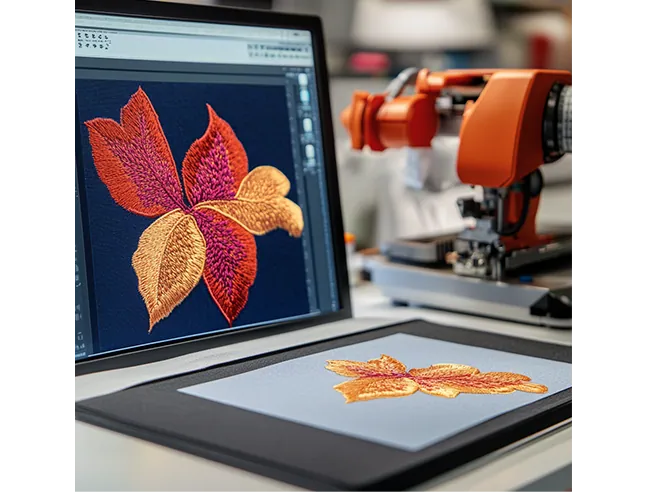Introduction
DST files are the universal language of commercial embroidery machines, but professional-quality DST digitizing requires more than just clicking “save as.” Industry experts know the secrets to crafting DST files through proper DST digitizing techniques that stitch perfectly across different machines and fabrics.
In this guide, you’ll discover the same DST digitizing methods professional digitizers use to create bulletproof DST files. Whether you’re supplying designs to clients or preparing files for production, these DST digitizing approaches will elevate your work and reduce frustrating stitch-outs.
Understanding DST Files
Why DST Dominates the Industry
DST (Tajima) format became the industry standard because:
- Nearly all commercial machines read it
- It efficiently handles complex stitch data
- Supports large design sizes
- Maintains consistent quality across devices
Key Components of a Well-Formed DST
Professional-grade DST files contain:
- Optimized stitch sequences
- Proper jump stitch reduction
- Correct thread trims and ties
- Appropriate density for the fabric
- Machine-friendly color changes
Essential Tools for Professional DST Creation
Industry-Standard Software
- Wilcom EmbroideryStudio
- Gold standard for production digitizing
- Advanced stitch optimization tools
- $3,000+ investment
- Pulse Ambassador
- Preferred by many large shops
- Excellent stitch path algorithms
- $1,500+
- Hatch Embroidery
- More affordable professional option
- Great auto-optimization features
- $999
Must-Have Accessories
- Color matching cards (Pantone to thread)
- Fabric sampler kit for testing
- Magnifying lamp for stitch inspection
- Tension gauge for perfect stitches
The Professional DST Digitizing Workflow
Step 1: Art Preparation
Experts always:
- Clean up artwork in vector software first
- Simplify complex color gradients
- Outline key elements clearly
- Set exact final dimensions
Step 2: Stitch Type Selection
Professional stitch assignments:
- Fill stitches: 0.4-0.5mm density for most fabrics
- Satin stitches: 3-5mm width for clean borders
- Running stitches: For fine details only
Step 3: Underlay Strategy
Pro underlay approaches:
- Edge run for crisp borders
- Zigzag for stability on stretchy fabrics
- Center run to prevent gapping
Step 4: Stitch Direction Mastery
Advanced techniques:
- Alternate directions in adjacent sections
- Follow natural contours of shapes
- Use 30° or 60° angles for visual interest
Step 5: Pull Compensation
Critical adjustments:
- Add 0.1-0.3mm compensation on fills
- Adjust based on fabric stretch tests
- More compensation for knits, less for wovens
Step 6: Trim Optimization
Production-saving tips:
- Minimize color changes where possible
- Group similar colors together
- Set auto-trim points strategically
Expert Tips for Flawless DST Files
Density Decisions
Ideal density ranges:
- Hats: 0.35-0.45mm
- Jackets: 0.4-0.5mm
- Towel: 0.5-0.6mm
- Stretchy fabrics: 0.3-0.4mm
Jump Stitch Reduction
Professional methods:
- Reorder stitch sequence logically
- Use tie-down stitches when needed
- Set maximum jump limits (typically 10-12mm)
Registration Tricks
For perfect alignment:
- Add guide stitches in first color
- Use common underlay across sections
- Include alignment marks for multi-hoop designs
Common DST Mistakes (And How Pros Avoid Them)
1. Overcrowding Stitches
Solution: Leave at least 1mm between elements
2. Ignoring Fabric Characteristics
Solution: Create separate files for different materials
3. Poor Thread Trim Placement
Solution: Add extra trims after dense sections
4. Inconsistent Stitch Lengths
Solution: Maintain 2.5-4mm lengths for fills
5. Neglecting Test Stitches
Solution: Always stitch on actual production fabric
Advanced DST Techniques
Creating Machine-Specific Variations
Experts often make:
- Modified DSTs for different machine types
- Alternate versions for various fabric weights
- Simplified editions for challenging materials
Production Optimization
Speed-boosting methods:
- Reduce total stitch count without sacrificing quality
- Minimize color changes in high-volume jobs
- Pre-program machine parameters into file
Quality Control Systems
Professional verification:
- Software simulation review
- Magnified stitch inspection
- Physical stitch-out on production fabric
- Wash/dry cycle testing
Free Tools for Improving DST Skills
While professional software is ideal, these free resources help:
- DST Viewer – Analyze professional files
- Ink/Stitch – Practice manual digitizing
- EmbroideryLibrary’s free designs – Study quality examples
- FCS University videos – Learn professional techniques
Transitioning From Hobbyist to Professional
Key mindset shifts:
- Focus on repeatable results over artistic flair
- Document all adjustments for consistency
- Build a library of tested settings
- Charge appropriately for your expertise
Industry Secrets for Perfect DSTs
Veteran digitizers know:
- The first 3 stitches determine tension balance
- Slight under-digitizing looks better than over-digitizing
- 90% of problems stem from poor underlay
- Every machine “reads” DST files slightly differently
Conclusion
Creating professional-quality DST files requires both technical knowledge and practical experience. By implementing these industry-approved techniques, you’ll produce files that stitch perfectly the first time, saving hours of frustration and material waste.
Remember that even experts continuously test and refine their methods. Start by mastering the fundamentals, build a library of proven settings, and never stop learning from each stitch-out.
Your journey to DST mastery begins with your next design. Apply one new technique from this guide, test it thoroughly, and watch your digitizing skills reach professional levels faster than you imagined possible.






